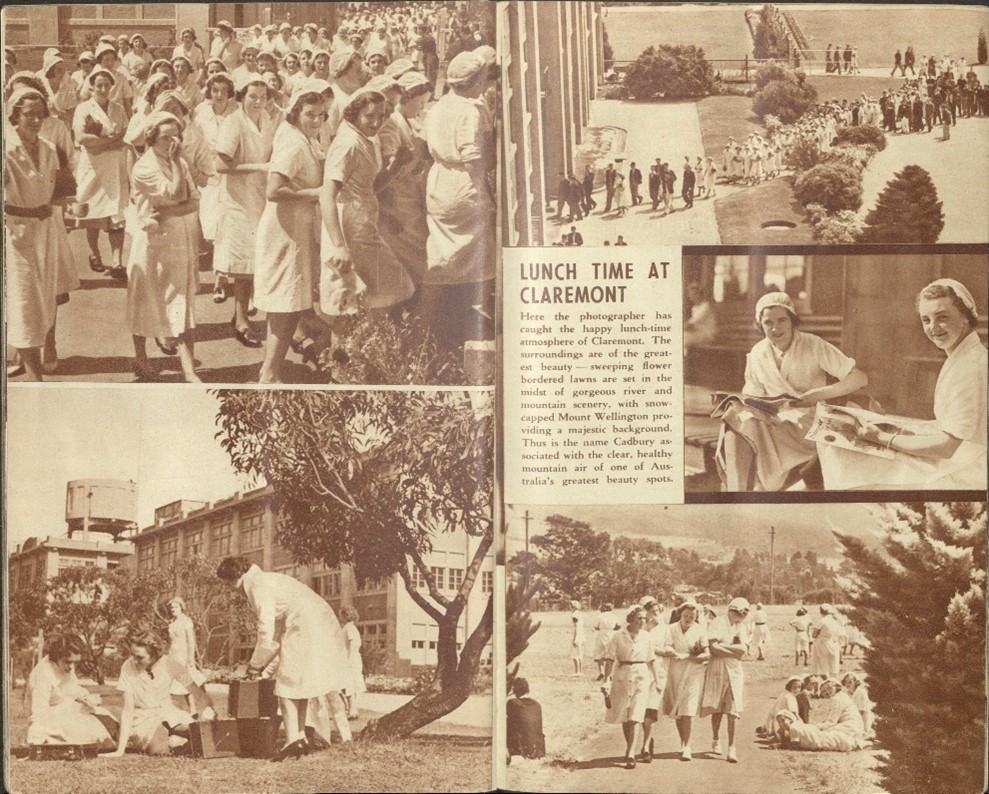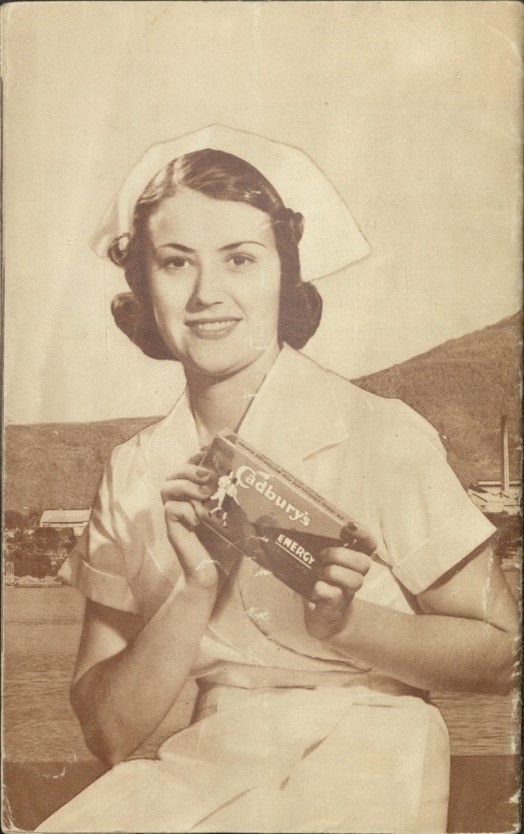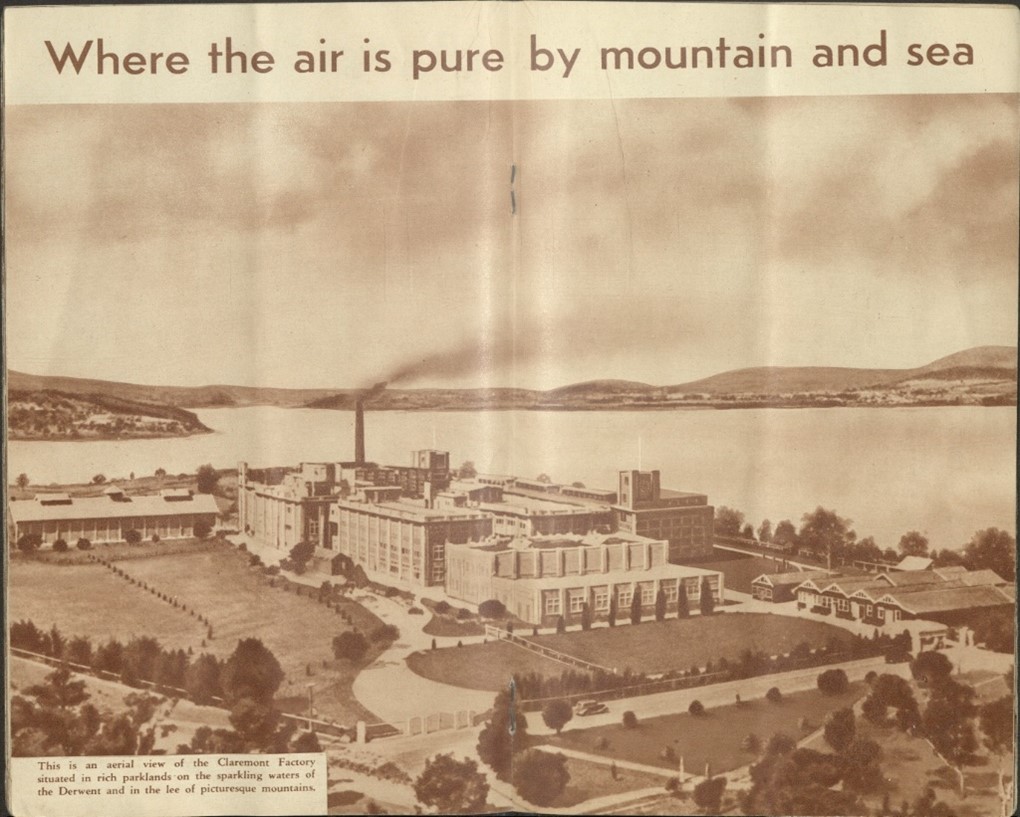‘By Mountain and Sea’: the Model Factory at Cadbury’s Claremont

It has been stated in Melbourne newspapers that there is a probability of the world-famous English firm of Cadbury’s cocoa and chocolate manufacturers establishing a factory in Melbourne or Sydney to supply Australian requirements. It is understood, however, that there is an equally good chance, if not a better one, because of climatic and other advantages, of the factory being established in Tasmania. … It is understood that the location of the factory will be decided upon very shortly. Should Tasmania be favoured, the State will be given a great lift up.
The Mercury, 25 Mar 1920, p.4
In January 1920, a group of executives from the English firms of Cadbury’s and Fry’s visited Tasmania to examine a possible site for a new factory. The group had already visited several other potential sites in Australia, including along the Paramatta River in Sydney, and the western suburbs of Melbourne (Freestone, Model Communities, p.151). The executives were, however, won over by the cool climate and beautiful scenery of Tasmania that they found to embody the Quaker values of the company. The site that was chosen was unique: a 100-hectare peninsula that extended out into the River Derwent at Claremont in the northern suburbs of Hobart. The site met all practical requirements for production too: the surrounding suburbs offered a ready workforce, and there was strong state government support, excellent infrastructure including an international shipping port, and a good power supply thanks to the Hydro.

The establishment of the Cadbury Factory at Claremont was to have wide-reaching economic as well as social benefits for the Tasmanian community in the one hundred years since it opened. Cadbury’s is one of Tasmania’s largest private employers. In 1960, there were 1,100 people employed at the Claremont site in a range of roles, such as the operation and maintenance of complex machinery, the transportation of the raw products of sugar, cocoa beans and milk, and the packaging and decorating of the chocolates. Many Tasmanians have a family connection to the factory at Claremont, while others fondly remember visiting the Cadbury Factory when it operated as a tourist attraction, and in particular, emerging with pockets full of delicious chocolates.
The history of the Cadbury Factory at Claremont and its wider legacy in Tasmania is well documented in a range of items held within the Tasmanian Archives and the State Library of Tasmania collections. We have extensive photographs illustrating the history of the site at Claremont, as well as the chocolate making process. We also have a comprehensive range of pamphlets that visitors who toured the Cadbury Factory were given as a souvenir to take home. The State Library collection holds nine different editions and versions of this souvenir pamphlet, the earliest dating from the mid-1920s.

Other than one example from the 1960s, all these souvenir pamphlets contain the phrase: ‘By Mountain and Sea’ in the title, with multiple uses throughout the publications. It was a phrase used and promoted by Cadbury’s in various marketing and advertising campaigns, one that acknowledges the Quaker ideals and principles upon which the Cadbury Company was originally founded. These ideals shaped the factory site at Claremont, and influenced the ways in which Cadbury’s was promoted in Australia.
The Origins of the Cadbury Company and the Bournville ‘Factory in a garden’
It was in 1824 at his grocery store at 93 Bull Street in the centre of Birmingham in the UK that John Cadbury (1801-1889), the founder of Cadbury’s, first started to make and sell chocolate. As a Quaker, John sought to develop a popular drink as an alternative beverage to alcohol, and so created his delicious drinking chocolate and cocoa powder (Crawford, More than a Glass and a Half, p.14). These products proved very popular, and in the decades that followed the family business, now led by John’s two sons Richard (1835-1899) and George (1839-1922), expanded. In 1849, Cadbury’s started to produce solid chocolate bars (Chinn, The Cadbury Story, p.9), and in 1878 production had expanded to such a degree that it required a move to larger premises on the outskirts of Birmingham.

The site that was chosen for the Cadbury factory was in a rural setting just outside the city of Birmingham, which they named Bournville (Chinn, The Cadbury Story, pp.19-23.). Here, Cadbury’s sought to establish a new sort of factory; it was to be a move away from the dirty, unhealthy factories in towns and cities that were so prominently established during the industrial revolution in the United Kingdom, instead, the factory at Bournville was to be surrounded by trees and gardens, with better conditions and lifestyles for the workers (Wordsworth, A History of Cadbury, pp.76-84). The factory at Bournville was in line with the Cadbury family’s Quaker ideals. The Quakers, otherwise known as the Religious Society of Friends, was founded in the seventeenth century in England, with key focuses on education, social welfare, and peace (Farrall, ‘Religious Society of Friends (Quakers)’, p.306). By the year 1900, the Cadbury factory site at Bournville had been developed to include numerous lifestyle and educational facilities to support the workers, including the construction of homes for employees in a model village, parks for recreation and sporting facilities. Bournville came to be famously known as the ‘factory in the garden’.
The model Cadbury factory at Claremont
As the factory site at Bournville was developing, Cadbury products and production was diversifying and expanding. From 1881, the company started exporting overseas, and merged with other confectionery companies, including English chocolate company J. S. Fry in 1919. A merger with the English company Pascall, was formalised in 1922. It was at this time, that Cadbury’s looked to expand their production into Australia, which was one of the largest chocolate-consuming markets, and it was the site at Claremont that they settled on.

After the formal opening of the Cadbury Factory in Claremont in October 1922, a variety of factory, storage, and administrative buildings were constructed at the site. This also included a train line extension and a train station. The complex logistics of importing the raw products to Tasmania, including the Cocoa from Ghana, sugar from Queensland, and the transportation of milk from dairy farms on the north-west coast of Tasmania, needed to be arranged. The intricate machinery was constructed by around forty Cadbury employees who were brought out from the UK to help set up the factory and to train the local workers.
The new site at Claremont provided an opportunity for Cadbury’s to construct a factory that embodied Quaker principles, just as they had done at Bournville. Gardens and outdoor spaces were developed around the Cadbury factory complex, to create idyllic surroundings for healthy living and a content staff. To aid in the work-life balance, in 1923 Cadbury’s built twenty houses for executive staff to live with their families, with a school located close by. The peninsula surrounding the factory came to be known as the Cadbury Estate. Sporting facilities included tennis courts, golf course, cricket ground and a bowling green. There were extensive gardens in which to walk around and relax during breaks.

A range of social activities and clubs were developed to support the education and social welfare of staff. A welfare committee was established, and nurses were available onsite. Dining facilities provided meals at reasonable prices. Educational facilities included a library and a range of special interest clubs, including a camera club called Candied Camera, and a Floricultural Society, as well as a youth club, and a girls’ club were established. Several of these clubs produced publications such as newsletters and magazines, such as Candied camera : news magazine of Cadbury’s Camera Club.

Education in Tasmanian schools and the community more broadly was central to the Cadbury philosophy. An Education team within Cadbury’s worked with the Tasmania Education Department to develop curriculum for Tasmanian Schools. They produced films, visual aids, and information packs about the production of cocoa and the innovations in technology used to produce it. One such series of photographs was produced in 1952; called ‘A Cake of Chocolate’, the stunning series of photographs illustrates the story of chocolate production through the eyes of a little girl called Joyce. Joyce explores the Claremont factory site with a guide, learning about the raw ingredients and their origins, as well as the technology used to manufacture chocolate. Her excitement and awe is captured.


‘Where the air is pure “By Mountain and Sea”’
Parallel to the development of a range of facilities at the Claremont factory site to support the health and welfare of workers was the promotion in advertising of Cadbury’s products as having health benefits. Advertisements highlighted Cadbury chocolate products as being made with the very cleanest of water, the freshest of milk and the best fruit produced in the clean Tasmanian air. In one advertising campaign from the 1930s, a series of Cadbury employees, dressed in white, starched uniforms that could be mistaken for nurses outfits, presents us with a chocolate bar. In the background is the Cadbury Factory, along with kunanyi / Mount Wellington and the River Derwent.

Images of kunanyi / Mount Wellington and the River Derwent, as well as the phrase ‘by mountain and sea’, recur through a great deal of advertising materials produced in the one hundred years since the Cadbury Claremont site was opened. The mountain and sea were key aspects of Cadbury’s health marketing strategy and messages, and have at their heart the Quaker philosophy. One particularly beautiful illustration of ‘By Mountain and Sea’ that was produced in the 1950s by Harry Kelly (d.1967). Harry Kelly was responsible for many of the iconic posters advertising Tasmania in the 1930s, including Tasmania, the Switzerland of the South.

Display now on: ‘By Mountain and Sea’: 100 Years of Cadbury’s at Claremont
Libraries Tasmania is currently celebrating the one hundred years of the Cadbury Chocolate Factory at Claremont with a display in the State Library of Tasmania and Tasmanian Archives Reading Room (on the second floor of the 91 Murray Street Building).
‘By Mountain and Sea’: 100 Years of Cadbury’s at Claremont presents information about the history of the company and its connections to dairy and fruit industries around Tasmania. The display showcases historic photographs, films, illustrations, and product artworks from the Libraries Tasmania collection. Excitedly, we have on display a collection of original sketches and mock-ups drawn by Vernon Hodgman (1909 – 1984). Vernon Hodgman was a commercial artist and industrial designer at Cadbury’s Claremont between 1928 and 1940, and in 1945 became the Head of the Design Studio. These items are on loan from the Hodgman Family.
You can also look through images of Cadbury’s online through the Tasmanian Archives and the State Library Flickr Album.

Bibliography
Select Primary Sources: Tasmanian Archive and State Library Collections
ED330/1/21 Film – A cake of chocolate (1950-1960)
AB869/1/431 Film – Cadbury’s factory – stock footage(1950)
NS5078/1/7 Cadbury Estate, Claremont, City of Glenorchy
By mountain and sea / Cadbury-Fry-Pascall Proprietary Limited (Claremont, Tasmania : Cadbury-Fry-Pascall Pty Ltd, [between 1922 and 1939?])
By mountain and sea: a souvenir of your visit to Cadbury’s Claremont, Tasmania. (Claremont, Tas : Cadbury, 193-?] ([Australia] : Sungravure)
By mountain and Sea: Claremont Tasmania, [Claremont, Tasmania]: [Cadbury-Fry-Pascall Pty. Ltd.], [between 1930 and 1939?].
Cadbury’s : the story of Tasmania’s famous factory by mountain and sea, Claremont, Tas. : Cadbury-Fry- Pascall Pty. Ltd., [ca. 1960]
Secondary Sources
Ted Best, ‘Cadbury’, in The Companion to Tasmanian History edited by Alison Alexander (Hobart: Centre for Tasmanian Historical Studies, The University of Tasmania, 2005), p.62.
Carl Chinn, The Cadbury Story: A Short History (Studley, England: Brewin Books, 1998)
Robert Crawford, More than a Glass and a Half: A history of Cadbury in Australia (Braddon, Australian Capital Territory: Halstead Press, 2022)
Stephanie Farrall, ‘Religious Society of Friends (Quakers)’, in The Companion to Tasmanian History edited by Alison Alexander (Hobart: Centre for Tasmanian Historical Studies, The University of Tasmania, 2005), p.306.
Robert Freestone, Model Communities: The Garden City Movement in Australia (Melbourne: Thomas Nelson, 1989)
Diane Wordsworth, A History of Cadbury (Barnsley, South Yorkshire: Pen & Sword History, 2018)


I still have my souvenir booklet, and cocoa bean booklet and project sheet from my visit in the 60s.
The heat and smell of chocolate became overwhelming, but we were allowed to take as many chocolates we liked from the sections we were shown.
The booklet mentions the various amenities, including a library: “For those who like to take things quietly, the Company maintains a well-stocked library at Claremont where thousands of neatly bound volumes are available for reading at home.”
I’m impressed by the values of some businesses in days past, where they fostered a wonderful sense of community and well-being, and looked after the welfare of employees in many ways.
My Mum Nellie Irene Froud Was the foreman of the cocoa Room,Dorothy Wyly was the boss . Nellie Irene Froud was there in the 1950’s. Retired 1961
Dear Helen, how interesting, thank you so much. Did your mother have fond memories of working at Cadbury’s? All the best, Ali
How interesting, must go and see the display. My dad Mervyn Limbrick worked there for 48 years. Retiring in the 70s. And my mum worked there before they married. Many happy memories. Especially getting to try new products before anyone else…and the rejects 🙂